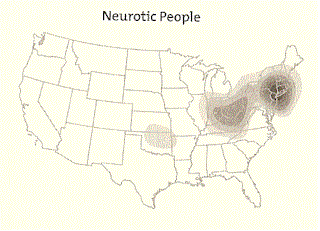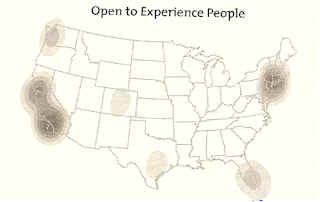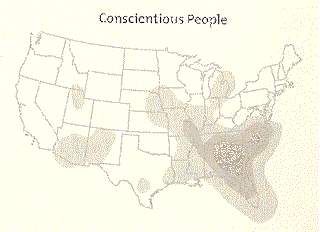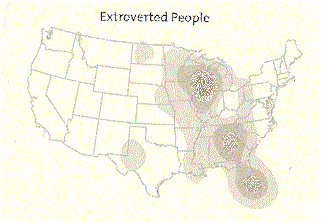|
There's
no better way to introduce you to the breakthrough
ideas that creative-class guru Richard Florida has
explored in his latest work, "Who's Your
City?" than to show you a map that appears
midway through the book.
By
way of preface, Florida has drawn upon a school
of social psychology that has identified five
fundamental personality traits by which all
individuals vary: openness to experience,
conscientiousness, extroversion (sociability),
agreeableness and neuroticism. For each of these
traits, an individual can be plotted along a spectrum between two
poles -- between introverted and extroverted for
instance, or between calm and high-strung.
Psychologists
have mapped the geographic location of some 600,000
Internet survey respondents, showing clearly that
different personality types vary in frequency by
region. That finding piqued the curiosity of Florida,
who popularized the idea in his earlier booked,
"The Rise of the Creative Class," that the artistically,
scientifically and economically creative members of
society are migrating to a centers of innovation
that produce an increasingly outsized
share of the nation's wealth.
In
his new book, Florida poses queries that few economic developers would ever think to
ask. Could cities and regions take
on personalities of their own, which over
time attract certain kinds of like-minded
people? If so, what are the implications for
regional economic development?
One
of the five personality maps in "Who's Your
City" shows that people with
"neurotic" personality traits -- i.e.
those who are nervous, high-strung, insecure and
prone to worry -- are highly concentrated in the
Northeastern U.S., particularly around New York
City. Secondary clusters reside in the "rust
belt" sector of the Midwest, and in
Kansas-Oklahoma.

This
map plots concentrations of nervous/high-strung
survey respondents (as contrasted to those who are
calm/relaxed).
The distribution of personality types has
implications for regional economic development,
argues Florida. Kvetching and creativity, it
appears, are incompatible. "Neuroticism is
negatively associated with top talent in the form of
human capital or the supercreative class," he
writes.
Conversely, he adds, "Regions with high
concentrations of highly educated and ultra-creative
individuals tend to be more emotionally stable, less
volatile and more resilient. This suggests, among
other things, that these are places where people may
be more likely to take risks because they're less
concerned about failure."
The
personality trait most closely aligned with
creativity, Florida suggests, is an openness to new
experiences. That trait is found most heavily in the
Northeast and the West Coast, with pockets in
Colorado, Texas and southern Florida. "Openness
to experience is the only personality type that
plays a consistent role in regional economic
development," he writes. "It is highly
correlated with jobs in computing, sciences, arts,
design, and entertainment; with overall human
capital levels, high-tech industry, income and
housing values."

This
map plots concentrations of survey respondents who
are
open to new experiences (as contrasted to those
who
are close-minded).
(Fortunately
for the economy of Gotham, New York City is a focal
point of "open to experience"
personalities as well as neurotics.)
By
exploring the intersection of psychology and
economic development, Florida has advanced his
theories about the creative class far beyond the thinking that inspired "The Rise
of the Creative Class." Postulating that
the percentage of creative-class occupations in a
region was
closely correlated with metrics of innovation and
wealth creation, he argued then that the creatives were
migrating to regions noted for the authenticity of
urban experience, openness to newcomers, tolerance
for cultural and ethnic diversity, and general
coolness. His theories sparked a wave of municipal
and regional initiatives to make themselves
attractive to these wealth creators.
In "Who's Your City," Florida
delves deeper into the sorting process that he sees
at the heart of the great migration taking place
in the United States. He now offers two more refined
explanations for the forces driving the migration.
One is economic, the other psychological.
In
1970, Florida notes, human capital was distributed fairly evenly
across the country. Over the past three decades, the percentage
of Americans with college degrees has doubled, but
the gains have gone overwhelmingly to regions like
Washington, D.C., and San Francisco while largely
bypassing regions like Detroit and Cleveland.
What's driving the migration? Florida argues that
the most talented and ambitious people need
to live in the anointed regions in order to
maximize their full economic potential. And in a
virtuous cycle, the influx of talented and ambitious
people spurs the productivity and innovation at the
heart of wealth creation. The superstar cities surge
ahead economically and cities like Motown
figuratively spin their wheels.
But
there's another process at work, Florida suggests.
Not all Americans are driven by a desire to maximize
income. For many, the decision of where to live is as
important to the pursuit of happiness as the choice
of a spouse. Americans seek communities
that best "fit" their personalities.
Geographic
differences in personality, Florida says, could have emerged as
a result of immigrants selectively migrating to
places that met their
psychological needs. Among the
five major personality types, people who display
high levels of openness to experience are both the
more adventuresome and the most mobile. They are the
ones most likely to pick up from Dullsville
and move somewhere more exciting.
Florida
then takes his thinking one step further:
"Perhaps the same types of people who are the
most likely to move are also the ones most likely to
innovate and start new firms. As more and more of
the people leave the places where they were born and
cluster together, the concentrations become hotbeds
of creative endeavor, innovation, start-up
companies, and economic growth."
I
find both the economic and psychological
explanations to be persuasive. Both work in tandem
to herd the restless, novelty-seeking and
wealth-creating elements of society into a
relatively small number of regional crucibles of creativity. Curiosity, energy, intensity, novelty seeking,
exploration -- all these attributes do tend to go
together. In a different stage of history, such
traits might have gotten people burned as heretics,
shunned as eccentrics, or banished to the
colonies. But in an age of unprecedented scientific
discovery, economic dynamism and cultural change,
such qualities become great virtues. In the 21st
century, such traits make people millionaires.
Where
does all this leave Virginia? Well, the Old Dominion
is situated at the edge of a major culture cluster
found mainly in the Southeastern U.S. and the Midwestern states. Most of Virginia is
dominated by two personality traits: agreeableness
and conscientiousness.
These
qualities sound positive, and to some extent they are.
"Agreeable types are warm, friendly,
compassionate and concerned for the welfare of
others," Florida writes. "They generally
trust other people and expect other people to trust
them." Agreeable people are nice to be around.
They build communities of trust. Regions full of agreeable people
tend to be more pleasant places to live. Which is great, if
"pleasant" is what you're looking for.
On
a more positive note, agreeable people work together
in teams and collaborative environments better than
disagreeable people do, and Florida's
massaging of the data suggests that there is a
slight correlation between agreeableness and a
regional capacity to innovate. Thus, from an
economic development perspective, this trait is a
mildly positive attribute.

This
map plots concentrations of agreeable survey
respondents
(as contrasted to those who are disagreeable).
Virginia
also falls into the personality zone strongly
associated with conscientious people.
"Conscientious types work hard and have a great
deal of self discipline. They are responsible,
detail-oriented, and strive for achievement,"
Florida states. They tend to be better-than-average workers on
almost any job.
While
it's important to have conscientious people on any
team, says Florida, conscientiousness as a dominant
personality type does not stimulate regional innovation.
"Conscientious individuals tend to be
rule-followers," he says. Give them a clearly defined task and
they will develop the most efficient procedure for
completing it. But when the task is not clearly
defined and requires creative thought, conscientious
individuals may struggle.

This
map plots concentrations of conscientious survey
respondents
(as contrasted to those who are disorganized).
The
maps for agreeable and conscientious personality
types show significant overlap -- they are the
defining characteristics of the Southeastern U.S.
Florida refers to this overlapping cluster as "conventional
or dutiful." Dutiful regions are a good fit for
model citizens, who want to fit in, who hold
conventional or traditional values, who obey the
rules and don't step out of line. People tend to
trust one another, and tend not to challenge
authority.
That's
a recipe for a more stable, harmonious society. But
watch
out, Florida warns: "The status quo orientation
and don't-rock-the-boat values of those regions
might not only damp down creativity and innovation
... but also encourage an outmigration of the open
types who tend to be the source of new creative
energy and innovation."
Wow.
Such concerns take economic development a long way from
industrial parks and Interstate highways.
Deconstructing a
region's psychological profile makes
the job a whole lot harder. As Florida observes,
it's one thing to attract a company or build a
new stadium; it's quite another to alter the
psychological make-up of a region to make it
attractive to the creative, open-to-new- experiences
types who propel the economy. Frankly, most regional
leaders wouldn't have
the slightest idea of where to begin to make the
needed changes -- or even if they wanted to.
But
deciphering the dynamics of why people in our mobile
society move from one region to another is a
challenge that every region needs to grapple with. If human capital is the driver of
economic development in the 21st century, as it
assuredly is, regional
leaders must understand why the most economically
innovative and productive people choose to live in a
relatively select number of places. "Who's Your City?" is
hardly the last word on the subject. But Richard Florida has
identified some of the key issues and given us a
framework for thinking about them.
--
June 2, 2008
Post
script. The fifth basic personality
characteristic is extroversion: the degree which
people are extroverted or introverted. On the whole,
Southerners are extroverts -- but the boundaries cut
through central Virginia. The population centers in
the eastern part of the state do not markedly display this
trait. Florida did not identify any strong
correlations between this characteristic and
economic performance.

This
map plots concentrations of extroverted survey
respondents
(as contrasted to those who are introverted).
Note
on maps: Large swaths of the country in these
maps appear blank. Do not take that as a sign that
the people living there have no personality at all!
Although Florida provides no explanation, I would
surmise that the blank spots reflect the fact that an
insufficient number of survey responses were
gathered in the corresponding zip codes to reach
statistically valid conclusions.
|
